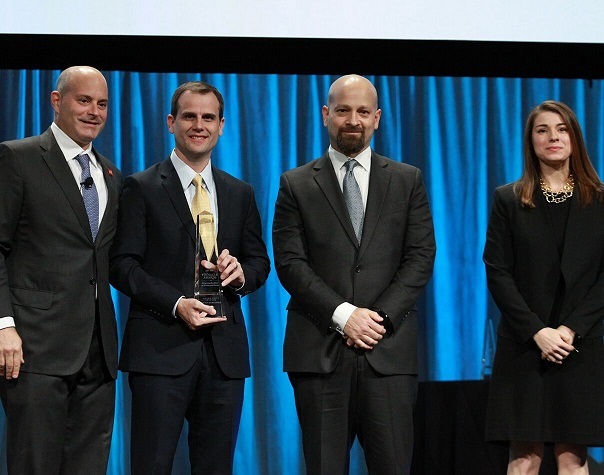Articles
How Hilton Improved its Liquidity Forecasting Capabilities
- By Andrew Deichler
- Published: 11/20/2015
 Hilton Worldwide outscored stiff competition to win AFP’s 2015 Pinnacle Grand Prize. The hospitality giant’s treasury team transformed a static view of multiple business units and regional forecasts into an agile, simplified liquidity forecast. Sponsored by Wells Fargo & Co., the Pinnacle Awards recognize excellence in treasury and finance.
Hilton Worldwide outscored stiff competition to win AFP’s 2015 Pinnacle Grand Prize. The hospitality giant’s treasury team transformed a static view of multiple business units and regional forecasts into an agile, simplified liquidity forecast. Sponsored by Wells Fargo & Co., the Pinnacle Awards recognize excellence in treasury and finance.The issues
In advance of its $13 billion debt refinancing and highly anticipated $2.3 billion initial public offering (IPO)—the largest ever in the hospitality industry—Hilton’s treasury department recognized that it needed to improve its liquidity forecasting capabilities.
Hilton’s existing forecast model, built in 2009, tracked cash movements at a granular level, which was critical in navigating through the downturn, explained Fred Schacknies, vice president and assistant treasurer for Hilton. “As we looked ahead to our refinancing and IPO in 2013 and the changes that would ensue, we realized we were spending too much time managing the data and not enough time analyzing the output,” he said. “We needed a tool that was no less accurate, but would let us focus on the forest over the trees.”
The old model lacked the flexibility to adapt to changes brought on by the forthcoming IPO, such as multiple tranches of secured and unsecured indebtedness and a realignment of global commercial cash flows. These changes would require Hilton to manage liquidity across multiple pools of ownership and several tiers of cash and revolver capacity.
Hilton was also focused on deleveraging, with the goal of paying down debt to achieve investment grade metrics. The new forecast model thus had to inform dynamic decision-making on large and sensitive prepayments of debt and other corporate events. The treasury department was charged with developing a new model to support Hilton’s evolving needs—and with fewer resources.
The solution
Treasury engaged FTI Consulting’s Office of the CFO to help develop a customized model. Designing and implementing the model took several months, much of which was spent mapping to data sources, Schacknies noted. “With a prototype in hand, we ran parallel with our legacy model for several weeks before cutting over,” he said. “But even after going live, we continue to recalibrate the model to adjust for nuances in the cash cycle.”
The new model leveraged existing data from financial planning and analysis (FP&A) to establish month-to-month trends and layered in regressions of historical daily balances to define normalized patterns for intra‐month cash flow. It then assessed cumulative outflows to identify low points in each monthly liquidity cycle. The new design allowed treasury to come to the realization that, as long as material events were reasonably mapped, the noise arising from the normal course of business didn’t matter.
The new approach enabled the team to spend less time tracking daily fluctuations. Instead, it could focus on optimizing transfers between liquidity pools and supporting strategic decision‐making on debt pay-downs, while reducing potential need for a drawdown. In time for the refinancing and IPO, the team had a six‐month rolling daily liquidity model that satisfied all needs.
The model’s flexibility both supported the complexity of the new capital structure and allowed Hilton to stress-test alternative scenarios, enhancing its liquidity planning capabilities. And because it leverages existing data sources, it is able to do so in half the resource hours, saving about $80,000 annually.
The solution has transformed the way in which Hilton’s treasury department looks at liquidity planning. The team can now plan for liquidity needs in the long term and evaluate the liquidity impacts of key strategic decisions in a much more efficient manner.
Since implementing the new model, Hilton has made significant strides towards achieving investment grade status, using free cash flow to prepay over $2 billion of debt, and has instituted a dividend. In the process, the company's credit ratings have improved and it has seen more than a $5 billion increase (25 percent) in its market capitalization.
“The efficiency benefits were immediate,” Schacknies said. “And very soon after going live, we began to appreciate the data we were seeing and to realize the questions we could be asking ourselves… How does a change today impact our options down the road?”
The model’s versatility has allowed Hilton to apply it for additional purposes; it is currently being used to inform decisions on investments of surplus cash, resulting in higher yield with a low risk of liquidation prior to maturity. Additionally, the underlying model data is used to forecast aspects of the Hilton’s foreign exchange exposure.
“We use this model to determine how any strategic or financial decision will affect our operating liquidity and our ability to return capital to investors as planned, from one period to the next,” Schacknies said. “Now that we are free of the old rigid framework, we can introduce changes on the fly and consider alternative scenarios in tandem.”
A longer version of this article appears in the November edition of AFP Exchange.
Copyright © 2024 Association for Financial Professionals, Inc.
All rights reserved.

